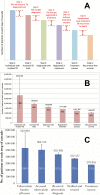Constructing care cascades for active tuberculosis: A strategy for program monitoring and identifying gaps in quality of care
- PMID: 30811385
- PMCID: PMC6392267
- DOI: 10.1371/journal.pmed.1002754
Constructing care cascades for active tuberculosis: A strategy for program monitoring and identifying gaps in quality of care
Abstract
The cascade of care is a model for evaluating patient retention across sequential stages of care required to achieve a successful treatment outcome. This approach was first used to evaluate HIV care and has since been applied to other diseases. The tuberculosis (TB) community has only recently started using care cascade analyses to quantify gaps in quality of care. In this article, we describe methods for estimating gaps (patient losses) and steps (patients retained) in the care cascade for active TB disease. We highlight approaches for overcoming challenges in constructing the TB care cascade, which include difficulties in estimating the population-level burden of disease and the diagnostic gap due to the limited sensitivity of TB diagnostic tests. We also describe potential uses of this model for evaluating the impact of interventions to improve case finding, diagnosis, linkage to care, retention in care, and post-treatment monitoring of TB patients.
Conflict of interest statement
I have read the journal's policy and the authors of this manuscript have the following competing interests: MP is a member of the Editorial Board of PLOS Medicine. All other authors declare that no competing interests exist.
Figures



References
-
- World Health Organization. Global tuberculosis report. Geneva: WHO, 2015. Contract No.: WHO/HTM/TB/2015.22.
-
- World Health Organization. Global strategy and targets for tuberculosis prevention, care, and control after 2015. Geneva: WHO, 2013. Contract No.: EB134/12.
-
- Mehta SH, Lucas GM, Solomon S, Srikrishnan AK, McFall A, Nandagopal P, et al. HIV Care Cascade Among Hard To Reach Populations in India: Need To Expand HIV Counseling and Testing. Top Antivir Med. 2014;22(e-1):565.
Publication types
MeSH terms
Grants and funding
LinkOut - more resources
Full Text Sources
Medical
Miscellaneous

